radiator cap BUICK REGAL 1997 Owners Manual
[x] Cancel search | Manufacturer: BUICK, Model Year: 1997, Model line: REGAL, Model: BUICK REGAL 1997Pages: 422, PDF Size: 21.34 MB
Page 253 of 422
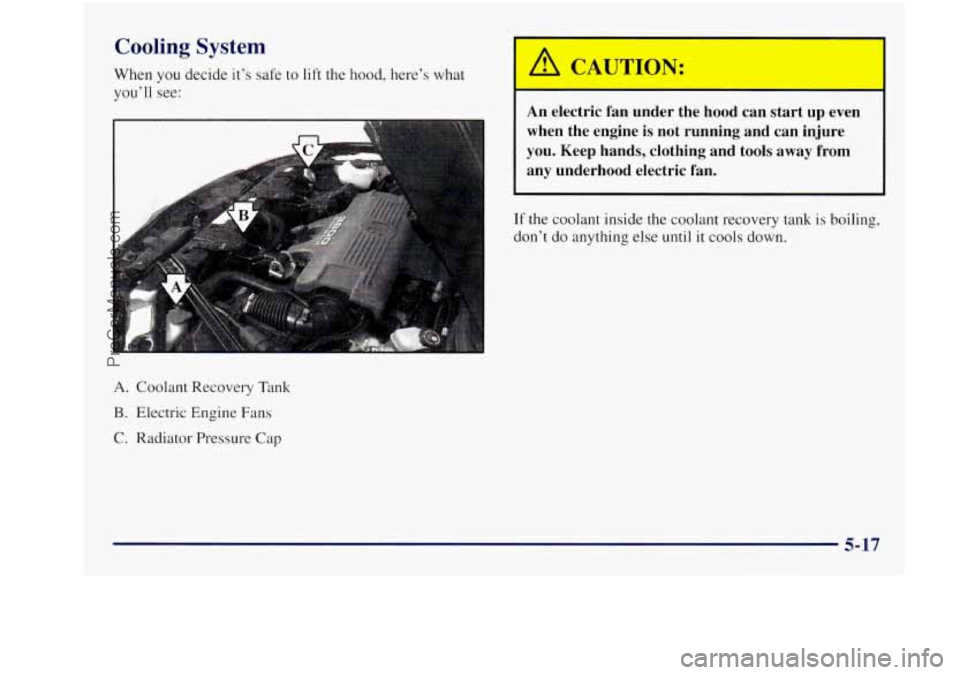
Cooling System
When you decide it’s safe to lift the hood, here’s what
you’ll see:
A. Coolant Recovery Tank
B. Electric Engine Fans
C. Radiator Pressure Cap
h!~ CAUTION:
An electric fan under the hood can start up even
when the engine
is not running and can injure
you. Keep hands, clothing and tools away from any underhood electric fan.
If the coolant inside the coolant recovery tank is boiling,
don’t
do anything else until it cools down.
ProCarManuals.com
Page 256 of 422
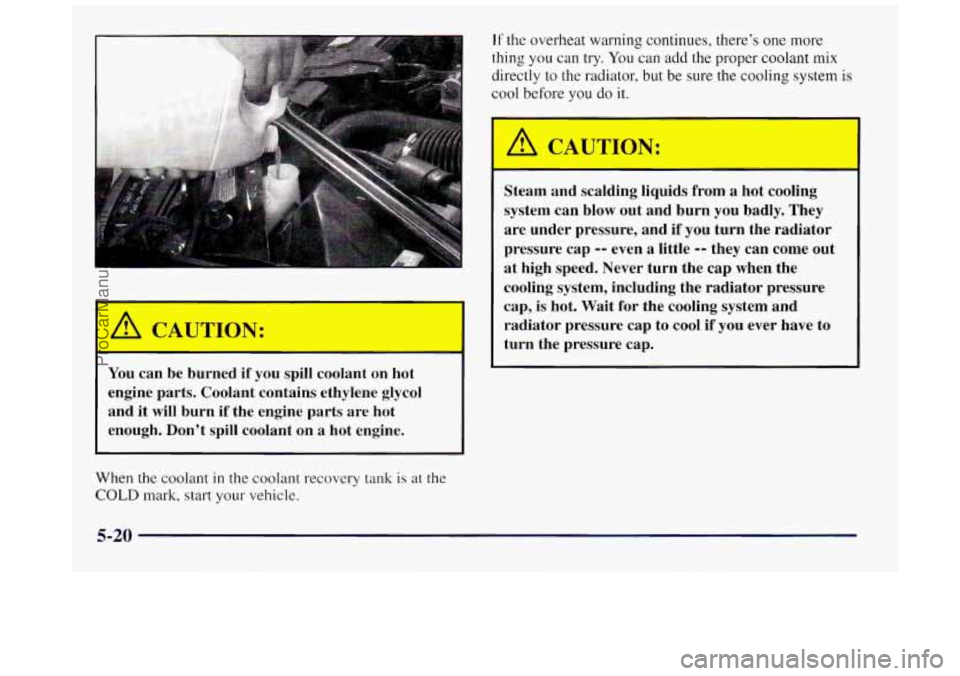
You can be burned if you spill coolant on hot
engine parts. Coolant contains ethylene glycol
and it will burn if the engine parts are hot
enough. Don’t spill coolant on a hot engine.
When the coolant
in the coolant recovery tank is at the
COLD mark, start your vehicle.
If the overheat warning continues, there’s one more
thing you can try.
You can add the proper coolant mix
directly to the radiator, but be sure the cooling system is
cool before you do it.
Steam and scalding liquids from
a hot cooling
system can blow out and burn you badly. They
are under pressure, and if you turn the radiator
pressure cap
-- even a little -- they can come out
at high speed. Never turn the cap when the
cooling system, including the radiator pressure
cap, is hot. Wait for the cooling system and
radiator pressure cap to cool if you ever have to
turn the pressure cap.
5-20
ProCarManuals.com
Page 257 of 422
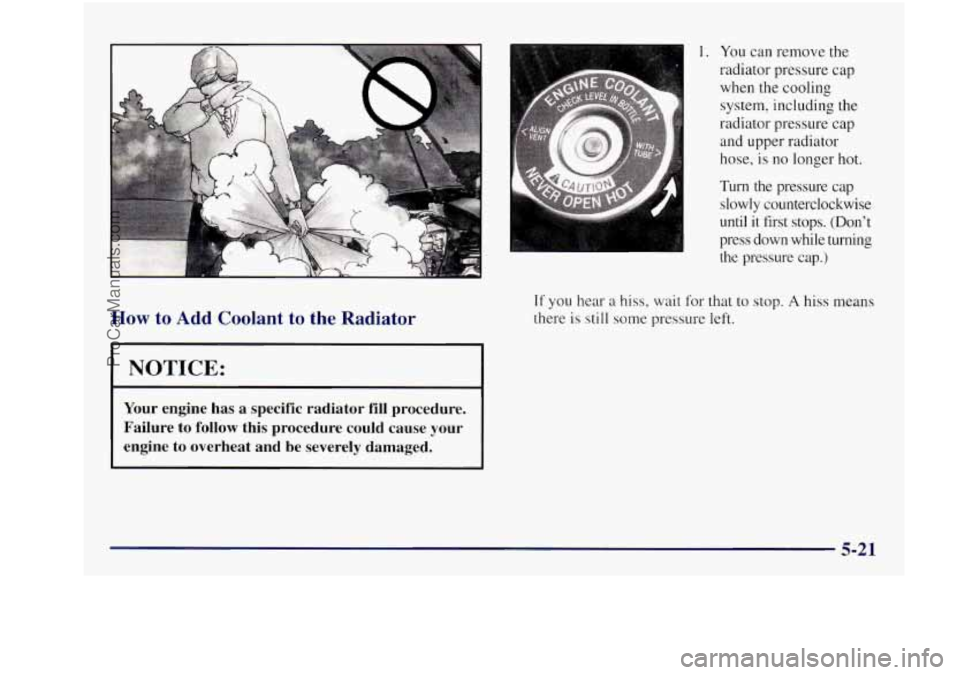
How to Add Coolant to the Radiator
I NOTICE:
Your engine has a specific radiator fill procedure.
Failure
to follow this procedure could cause your
engine to overheat and be severely damaged.
1. You can remove the
radiator pressure cap
when the cooling
system, including the
radiator pressure cap
and upper radiator
hose, is no longer hot.
Turn the pressure cap
slowly counterclockwise
until it first stops. (Don’t
press down while turning
the pressure cap.)
If you hear a hiss, wait for that to stop. A hiss means
there is still some pressure left.
ProCarManuals.com
Page 259 of 422
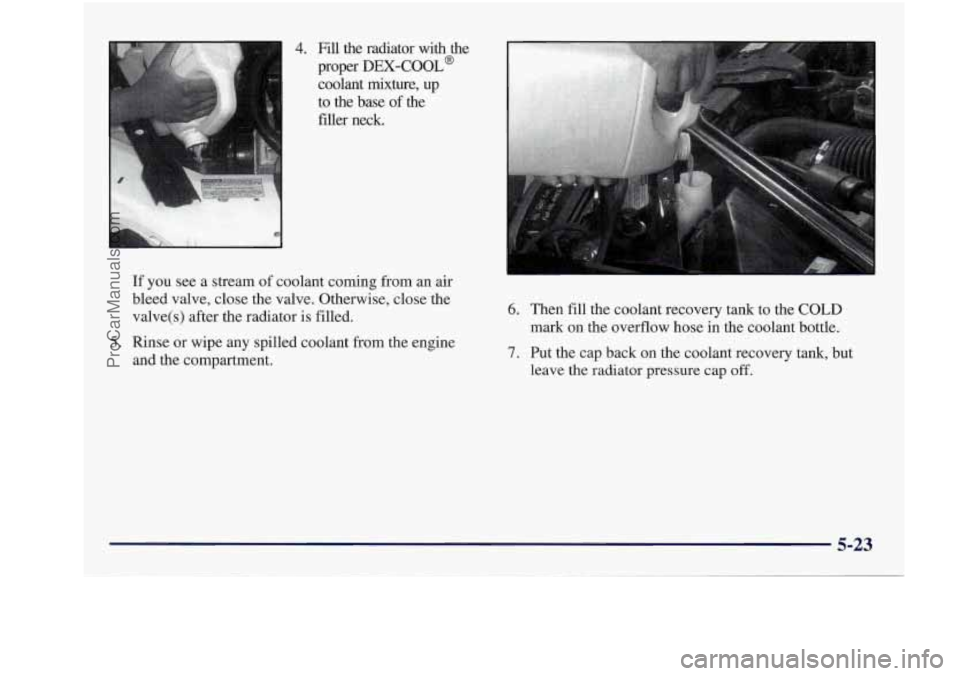
4. Fill the radiator with the
proper
DEX-COOL@
coolant mixture, up
to the base
of the
filler neck.
If you see a stream of coolant coming from an air
bleed valve, close the valve. Otherwise, close the
valve(s) after the radiator is filled.
5. Rinse or wipe any spilled coolant from the engine
and the compartment.
6. Then fill the coolant recovery tank to the COLD
mark on the overflow hose in the coolant bottle.
7. Put the cap back on the coolant recovery tank, but
leave the radiator pressure cap
off.
5-23
ProCarManuals.com
Page 260 of 422
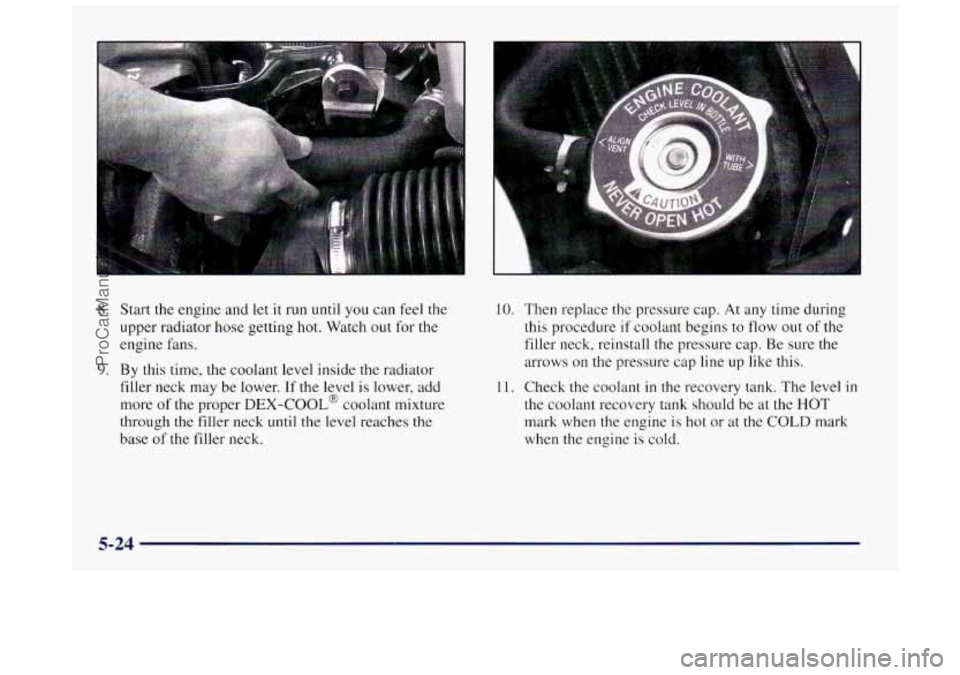
8. Start the engine and let it run until you can feel the
upper radiator hose getting hot. Watch out for
the
engine fans.
9. By this time, the coolant level inside the radiator
filler neck may be lower. If the level is lower, add
more of
the proper DEX-COOL@ coolant mixture
through the filler neck until
the level reaches the
base of the filler neck.
10. Then replace the pressure cap. At any time during
this procedure
if coolant begins to flow out of the
filler neck, reinstall the pressure cap. Be sure the
arrows on the pressure cap line up like this.
1 1. Check the coolant in the recovery tank. The level in
the coolant recovery tank should be at the HOT
mark when the engine is hot or at the COLD mark
when the engine is cold.
5-24
ProCarManuals.com
Page 285 of 422
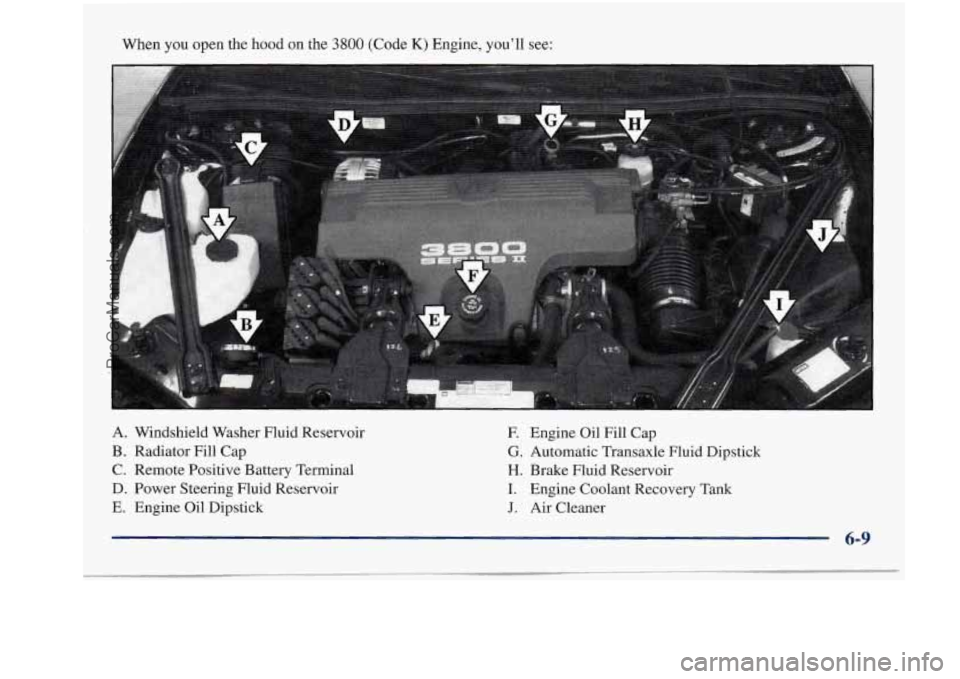
When you open the hood on the 3800 (Code K) Engine, you’ll see:
A. Windshield Washer Fluid Reservoir
F. Engine Oil Fill Cap
B. Radiator Fill Cap
G. Automatic Transaxle Fluid Dipstick
C. Remote Positive Battery Terminal H. Brake Fluid Reservoir
D. Power Steering Fluid Reservoir
I. Engine Coolant Recovery Tank
E. Engine Oil Dipstick J. Air Cleaner
6-9
ProCarManuals.com
Page 286 of 422
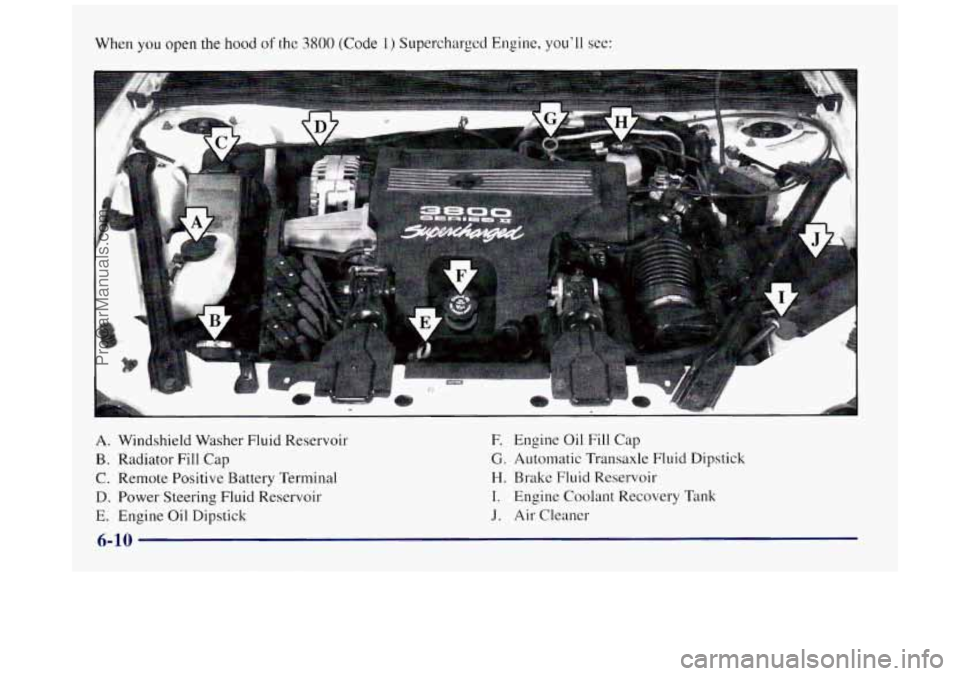
When you open the hood of the 3800 (Code 1) Supercharged Engine, you’ll see:
A. Windshield Washer Fluid Reservoir
B. Radiator Fill Cap
C. Remote Positive Battery Terminal
D. Power Steering Fluid Reservoir
E. Engine Oil Dipstick
E Engine Oil Fill Cap
G. Automatic Transaxle Fluid Dipstick
H. Brake Fluid Reservoir
I. Engine Coolant Recovery Tank
J. Air Cleaner
6-10
ProCarManuals.com
Page 301 of 422
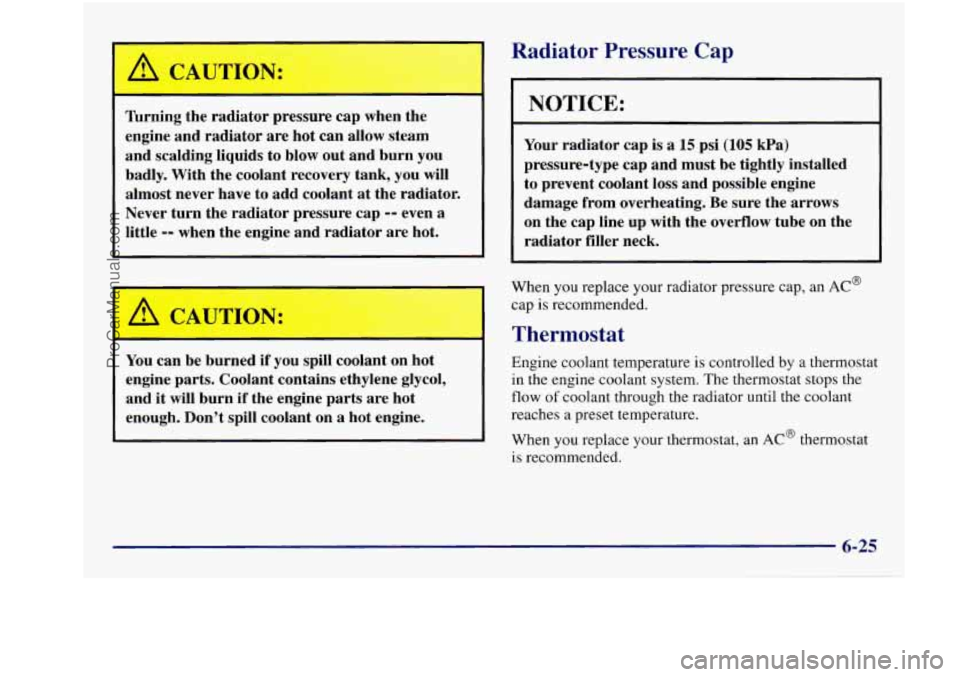
.- I, 7.5,
I’urning the radiator pressure cap when the
engine and radiator
are hot can allow steam
and scalding liquids to blow out and burn you
badly. With the coolant recovery tank, you will
almost never have to add coolant at the radiator.
Never turn the radiator pressure cap
-- even a
little
-- when the engine and radiator are hot.
- .. .
You can be burned if you spill coolant on hot
engine parts. Coolant contains ethylene glycol,
and it will burn if the engine parts are hot
enough. Don’t spill coolant on a hot engine.
_c
Radiator Pressure Cap
Your radiator cap is a 15 psi (105 kPa)
pressure-type cap and must be tightly installed
to prevent coolant loss and possible engine
damage from overheating. Be sure the arrows
on the cap line up with the overflow tube on the
radiator filler neck.
When you replace your radiator pressure cap, an AC@
cap is recommended.
Thermostat
Engine coolant temperature is controlled by a thermostat
in the engine coolant system. The thermostat stops the
flow of coolant through the radiator until the coolant
reaches a preset temperature.
When
you replace your thermostat, an AC@ thermostat
is recommended.
ProCarManuals.com
Page 341 of 422
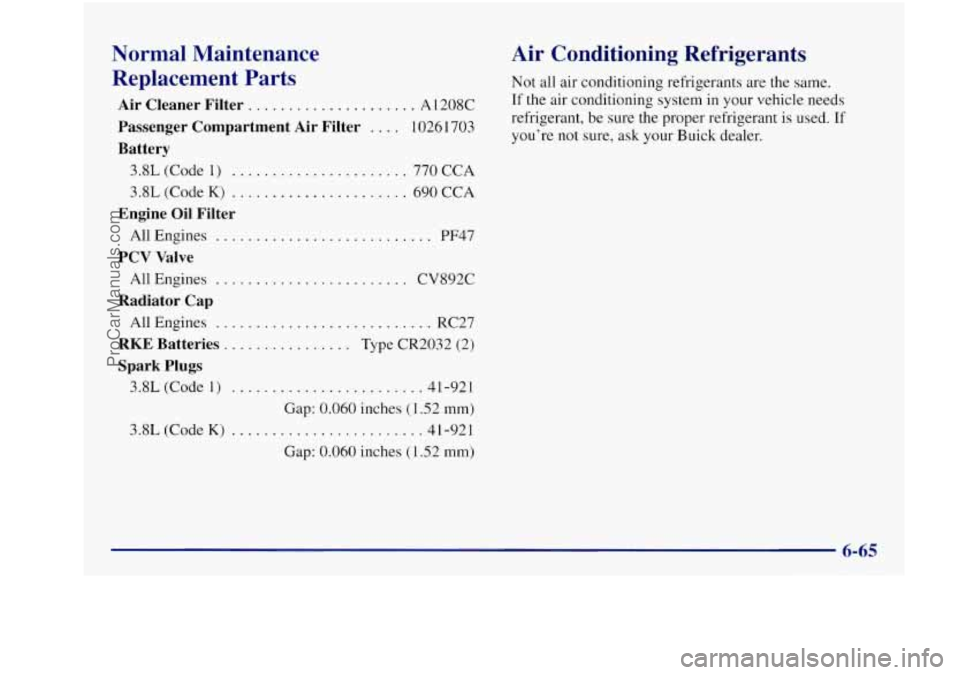
Normal Maintenance
Replacement Parts
Passenger Compartment Air Filter .... 10261 703
Air Cleaner Filter ..................... A 1208C
Battery
3.8L (Code 1) ...................... 770 CCA
3.8L (Code K) ...................... 690 CCA
Engine Oil Filter
All Engines ........................... PF47
PCV Valve
All Engines ........................ CV892C
Radiator Cap
All Engines ........................... RC27
RKE Batteries ................ Type CR2032 (2)
Spark Plugs
3.8L (Code 1) ........................ 41-921
Gap:
0.060 inches (1.52 mm)
3.8L (Code
K) ....................... .41-921
Gap: 0.060 inches (1.52
mm)
Air Conditioning Refrigerants
Not all air conditioning refrigerants are the same.
If the air conditioning system in your vehicle needs
refrigerant, be sure the proper refrigerant is used. If
you’re not sure, ask your Buick dealer.
ProCarManuals.com
Page 369 of 422
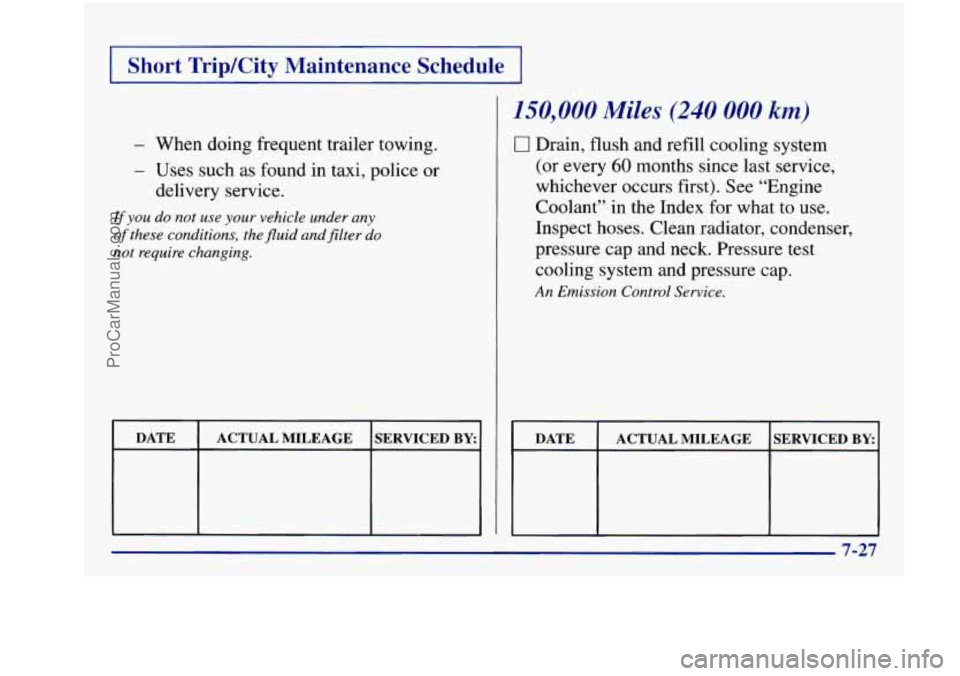
I Short Trip/City Maintenance Schedule I
- When doing frequent trailer towing.
- Uses such as found in taxi, police or
delivery service.
If you do not use your vehicle under any
of these conditions, the fluid and filter do
not require changing.
DATE
SERVICED BY: ACTUAL MILEAGE
150,000 Miles (240 000 km)
0 Drain, flush and refill cooling system
(or every
60 months since last service,
whichever occurs first). See “Engine
Coolant” in the Index for what to use.
Inspect hoses. Clean radiator, condenser,
pressure cap and neck. Pressure test
cooling system and pressure cap.
An Emission Control Service.
DATE
SERVICED BY: ACTUAL MILEAGE
7-27
ProCarManuals.com